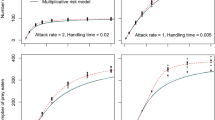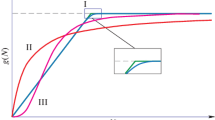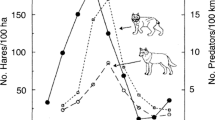Summary
The usual method of estimating the mutual interference constant, m, assumes a linear (type I) functional response of predators. In the cases where the response is not linear, the application of the method introduces a bias in the estimation of the searching efficiencies. It is shown that, as a consequence, the value of m is underestimated. A new method is proposed, which allows for a type II functional response due to a handling time. A comparative analysis of 15 data sets from the literature shows that the proposed method gives values of m that are consistently higher than those estimated by the traditional method. The new method calculates the parameters with nonlinear regression and provides standard errors for the estimates. Therefore, the reliability of the searching efficiencies, the handling time and the constant m can be quantified. Very few of the interference constants are significantly different from m=1. This special value implies that the functional response is a function of the ratio of prey and predator densities. These empirical findings support the suggestion of Arditi and Ginzburg (1989) that the functional response might often be ratio-dependent, especially in complex and heterogeneous situations.
Similar content being viewed by others
References
Arditi R (1983) A unified model of the functional response of predators and parasitoids. J Anim Ecol 52:293–303
Arditi R, Ginzburg LR (1989) Cou-ling in predator-prey dynamics: ratio-dependence. J Theor Biol 139:311–326
Beddington JR (1975) Mutual interference between parasites or predators and its effect on searching efficiency. J Anim Ecol 44:331–340
Chant DA, Turnbull AL (1966) Effects of predator and prey densities on interactions between goldfish and Daphnia pulex (de Geer). Can J Zool 44:285–289
Edwards RL (1961) The area of discovery of two insect parasites, Nasonia vitripennis (Walker) and Trichogramma evanescens Westwood, in an artificial environment. Can Entomol 93:475–481
Eveleigh ES, Chant DA (1982) Experimental studies on acarine predator-prey interactions: the effects of predator density on prey consumption, predator searching efficiency, and the functional response to prey density (Acarina: Phytoseiidae). Can J Zool 60:611–629
Free CA, Beddington JR, Lawton JH (1977) On the inadequacy of simple models of mutual interference for parasitism and predation. J Anim Ecol 46:543–554
Getz WM (1984) Population dynamics: a per capita resource approach. J Theor Biol 108:623–643
Hassell MP (1978) The Dynamics of Arthropod Predator-Prey Systems. Princeton University Press, Princeton
Hassell MP, Varley GC (1969) New inductive population model for insect parasites and its bearing on biological control. Nature 223:1133–1137
Jones TH, Hassell MP (1988) Patterns of parasitism by Trybliographa rapae, a cynipid parasitoid of the cabbage root fly, under laboratory and field conditions. Ecol Entomol 13:309–317
Katz CH (1985) A nonequilibrium marine predator-prey interaction. Ecology 66:1426–1438
Kfir R (1983) Functional response to host density by the egg parasite Trichogramma pretiosum. Entomophaga 28:345–353
Kumar A, Tripathi CPM (1985) Parasitoid-host relationship between Trioxys (Binodoxys) indicus Subba Rao and Sharma (Hymenoptera: Aphididae) and Aphis craccivora Koch (Hemiptera: Aphididae): effect of host plants on the area of discovery of the parasitoid. Can J Zool 63:192–195
Mertz DB, Davies RB (1968) Cannibalism of the pupal stage by adult flour beetles: an experiment and a stochastic model. Biometrics 24:247–275
Rogers DJ (1972) Random search and insect population models. J Anim Ecol 41:369–383
Royama T (1971) A comparative study of models for predation and parasitism. Res Popul Ecol [Suppl 1]
Westernhagen H, von Rosenthal H (1976) Predator-prey relationship between Pacific herring, Clupea harengus pallasi, larvae and a predatory hyperiid amphipod, Hyperoche medusarum. Fish Bull 74:669–674
Author information
Authors and Affiliations
Rights and permissions
About this article
Cite this article
Arditi, R., Akçakaya, H.R. Underestimation of mutual interference of predators. Oecologia 83, 358–361 (1990). https://doi.org/10.1007/BF00317560
Received:
Accepted:
Issue Date:
DOI: https://doi.org/10.1007/BF00317560




